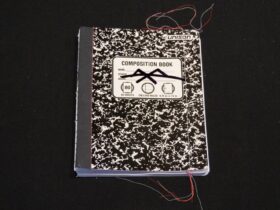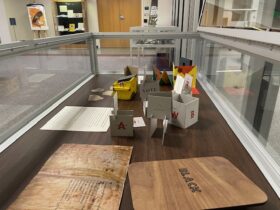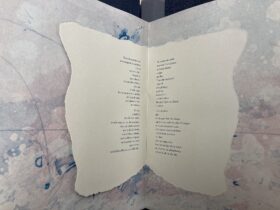Rock & Roll Rock Hall of Fame Turns 20!
To commemorate the 2oth anniversary of the Rock & Roll Hall of Fame, the September book of the month is LSD: The Library of Julio Santo Domingo. The two volume set published in 2013 was written not just to celebrate a remarkable collection put together by a determined individual, but also to offer a scholarly overview of the subject matter involved.
LSD: the Library of Julio Santo Domingo (Call Number NX180.S6 W38 2013 v.1-2), by Peter Watts is housed in the Special Collections department of the Binghamton University Libraries. the department is open to the public, Monday – Friday from 10:00 am – 4:00 pm, and by appointment.
(from LSD: the Library of Julio Santo Domingo)
The Julio Mario Santo Domingo Collection, the world’s largest private collection of material documenting altered states of mind, has been placed on long-term deposit by his son, Julio Mario Santo Domingo III at Harvard University and the Rock and Roll Hall of Fame . Including rare books, manuscripts, posters, photographs, audio material, and popular and underground cultural ephemera of all kinds, the 50,000+ item collection will support teaching and research in many fields across the University.
The collection was formed by Julio Mario Santo Domingo Jr. (1957-2009), an investment advisor who resigned his business interests to devote himself to collecting. His acquisitions followed his wide-ranging personal interests, from a passion for French 19th-century poetry and fin-de-siècle culture that developed when studying comparative literature at Columbia University; to exploring man’s inner world through drugs, mysticism, the occult, sex, social taboos; to a fascination with the interrelationships of “high” and “low” culture. In very basic terms, his collecting centered on sex, drugs, and rock and roll. In addition to the collection now deposited at Harvard, he formed a major Rock and Roll Collection (now at the Rock and Roll Hall of Fame in Cleveland), and the world’s largest collection of opium pipes.
![John Collier. <em>Short stories</em>. New York: Editions for the Armed Services, [1945]. SF 479.](http://hcl.harvard.edu/images/libraries/houghton/santo_domingo/17fumee.jpg)
The collection documents psychoactive drugs and their physical and social effects, from cultivation and synthesis to the myriad cultural and counter-cultural products such altered states of mind have inspired and influenced. Rich in scientific and medical works on cannabis, hashish, opium, coca, peyote, LSD, anesthetics and various derivatives, it documents in depth both the benefits of controlled use and the horrors of addiction. The bulk of the collection, however, explores drug use by individuals and the influence such use and users had on their society, with emphasis on the 19th and 20th centuries in America and France. The collections was also known as the Ludlow Santo Domingo (LSD) Library, following Santo Domingo’s acquisition and integration of the Fitz Hugh Ludlow Library of San Francisco in 2001.
Opened on September 1, 1995, the Rock and Roll Hall of Fame Museum was created on April 20, 1983, by Atlantic Records founder and chairman Ahmet Ertegun. He assembled a team that included attorney Suzan Evans, Rolling Stone magazine editor and publisher Jann S. Wenner, attorney Allen Grubman and record executives Seymour Stein, Bob Krasnow and Noreen Woods. The Foundation began inducting artists in 1986, but the Hall of Fame still had no home. The search committee considered several cities, including Memphis (home of Sun Studios and Stax Records), Detroit (home of Motown Records), Cincinnati (home of King Records), New York City, and Cleveland.
Cleveland lobbied for the museum, citing that WJW disc jockey Alan Freed both coined the term “rock and roll” and heavily promoted the new genre—and that Cleveland was the location of Freed’s Moondog Coronation Ball, the first major rock and roll concert. In addition, Cleveland cited radio station WMMS, which played a key role in breaking several major acts in the U.S. during the 1970s and 80s, including artist David Bowie, who began his first U.S. tour in the city, Bruce Springsteen, Roxy Music, and Rush among many others.[1] Cleveland was also one of the premier tour stops for most rock bands.
Civic leaders in Cleveland pledged $65 million in public money to fund the construction. A petition drive was signed by 600,000 fans favoring Cleveland over Memphis, and Cleveland ranked first in a 1986 USA Today poll asking where the Hall of Fame should be located. On May 5, 1986, the Hall of Fame Foundation chose Cleveland as the permanent home of the Rock and Roll Hall of Fame and Museum.
During early discussions on where to build the Hall of Fame and Museum, the Foundation’s board considered the Cuyahoga River. Ultimately, the chosen location was in downtown Cleveland by Lake Erie, just east of Cleveland Browns Stadium and the Great Lakes Science Center.
At one point in the planning phase when a financing gap existed, planners proposed locating the Rock Hall in the then-vacant May Company Building, but finally decided to commission architect I. M. Pei to design a new building. Initial CEO Dr. Larry Thompson facilitated I. M. Pei in designs for the site. Pei came up with the idea of a tower with a glass pyramid protruding from it. The museum tower was initially planned to stand 200 ft (61 m) high, but had to be cut down to 162 ft (49 m) due to its proximity to Burke Lakefront Airport. The building’s base is approximately 150,000 square feet (14,000 m2). The groundbreaking ceremony took place on June 7, 1993. Pete Townshend, Chuck Berry, Billy Joel, Sam Phillips, Ruth Brown, Sam Moore of Sam and Dave, Carl Gardner of the Coasters and Dave Pirner of Soul Asylum all appeared at the groundbreaking.
The museum dedicated on September 1, 1995, with the ribbon being cut by an ensemble that included Yoko Ono and Little Richard, among others, before a crowd of more than 10,000 people. The following night an all-star concert was held at the stadium. It featured Chuck Berry, Bob Dylan, Al Green, Jerry Lee Lewis, Aretha Franklin, Bruce Springsteen, Iggy Pop, John Fogerty, John Mellencamp and many others.
In addition to the Hall of Fame inductees, the museum documents the entire history of rock and roll, regardless of induction status. Hall of Fame inductees are honored in a special exhibit located in a wing that juts out over Lake Erie.







